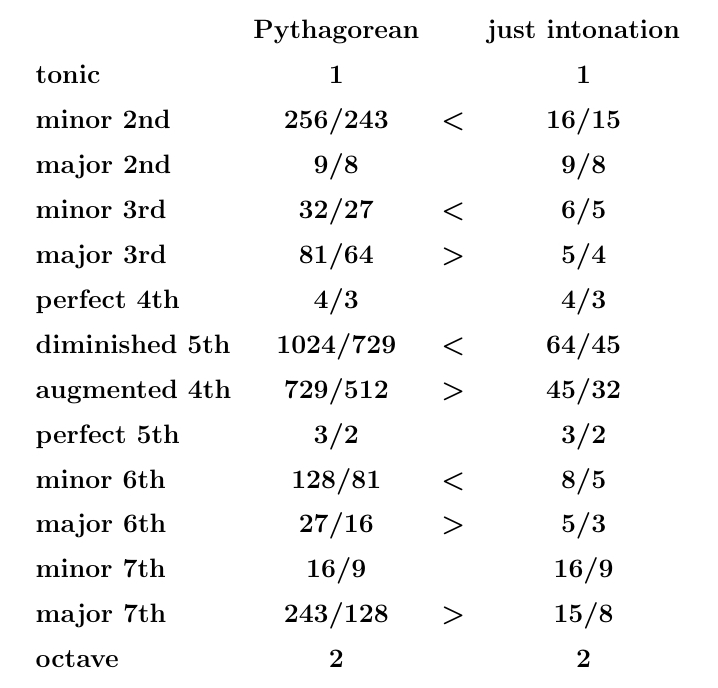
I've been doing a lot of work in the last year with Nate Osgood. He was one of my best friends when I was a grad student at MIT. I was in math; he was in computer science. We got up to some interesting things like studying the Voynich manuscript and trying to use infrared photography to find hidden writing in an old book by John Dee, an important figure in the British occult. (No luck.)
Eventually he got a permanent job in Canada at the University of Saskatchewan. I more or less lost track of what he was doing. But it turns out he was applying computer science to public health. He became an expert in epidemiological modeling.
When COVID hit, he was called in by the government of Canada to help run their modeling of COVID.
Also when COVID hit, some folks associated to the Topos Institute — Evan Patterson and Micah Halter — started applying some math I developed — structured and decorated cospans — to creating software that makes it easier to assemble complicated models in epidemiology out of simpler parts. They blogged about this, and it not only excited me, it also got a number of professional epidemiologists interested. We started meetings with them.
Meanwhile, Nate was getting interested in applied category theory in general, and this approach to epidemiological modeling software in particular. He started attending the Topos Institute seminar series, and eventually reached out to Evan and me. We started developing some software, also based on my math, but better than the earlier stuff: as a professional epidemiologist Nate knew what epidemiologists really needed, and what was missing from existing software.
So, starting about two years ago, a team of people including Nate, his grad student Xiaoyan Li, and Evan Patterson and Sophie Libkind at the Topos Institute created some really nice software for epidemiological modeling and published two papers about it:
One next step is for Nate to teach epidemiologists to use this software, which he can do in his classes. Also, we're meeting at the International Centre for Mathematical Sciences in Edinburgh next summer for 6 weeks to work on new math and software for 'agent-based models'. Unlike the 'stock-flow models' we'd been working on so far, which treat people en masse, agent-based models simulate individual agents and how they respond to conditions and interact with each other. Stock-flow models and agent-based models are both popular in epidemiology.
What I hadn't known until recently is that the head of the Fields Institute, Kumar Murty, was interested in this work. The Fields Institute, based in Toronto, is mainly known for handing out the Fields Medal. But their main business is hosting lots of conferences on math.
When COVID hit, the conferences had to stop for a while — so Kumar Murty, being a clever guy, decided to start a Fields Institute program on the math of epidemiology! This helped people meet virtually and work together on a pressing problem, namely COVID. And of course he met Nate, who was important in COVID modeling in Canada.
Now the Fields Institute is back to having meetings. And a while ago Nate told me that Kumar was interested in having a Fields Institute meeting about epidemiological modeling, run by Nate and me. That sounded cool, so we arranged a Zoom meeting with Kumar on September 4th.
But when the meeting happened, Kumar suggested something completely different! He said that we wanted the Fields Institute to run a big multi-million-dollar project on the math of climate science. In fact he said they'd already started, but it wasn't going anywhere because people were pulling in too many directions. He said they needed a "champion" who would direct the program. And he asked me to do that!
I was shocked, mainly because I had expected a conversation about a different, smaller subject — but also because I'd been trying for about a decade to get mathematicians working on climate change, and I'd felt that nobody was listening. Now, all of a sudden it seemed like someone finally had!
After some hesitation I said that yes, I was very interested. In fact I was torn, because I realized this would upend my life and at least temporarily put an end to my plans of thinking and writing in peaceful retirement. But the opportunity to do more about climate change is not something I can turn down. It would be like saying you don't want to pull someone out of a burning building because you were just about to take a nap.
We all agreed that the focus should not be on the math of modeling the geophysics of climate change — there are plenty of people working on that, doing quite well, and what we really need is to do something about the climate crisis, not just study it. We should create new math that helps people take action on climate change. There are dozens of directions this could go in, but it's my job to choose one, or a few, and find people who are working on those, and start catalyzing more rapid progress.
So, I've started working on this. My very first step was to pull in Nate as a kind of co-director. This makes sense because Nate's and my next planned project, on agent-based models, is quite relevant to climate change as well as disease.
For example, there's an engineer named Eric Miller at the University of Toronto who has a big model of the Toronto transportation system, which he uses to help it respond better to the increasing number of weather disasters. One of my jobs now is to talk to him, and lots of other people, and try to get mathematicians (and computer scientists) to help them out with better math (and software). Nate will be incredibly helpful because he understands agent-based models a lot better than me: he uses them regularly.
It's all quite exciting! Last week I went to Cambridge University and bumped into a bunch of computer scientists working on climate change and the human response to it. The Fields Institute project gave me a good excuse to start talking to them. I have to synthesize what they're saying and try to figure out what are the most impactful things to do.
You can read a tiny bit more about this project here:
In 'Pythagorean tuning’ all the frequency ratios between tones are products of powers of the primes 2 and 3. I explained this system in detail here. Because the largest prime it uses is 3, we say Pythagorean tuning is a form of '3-limit tuning'. One can imagine other forms of 3-limit tuning, though no other is as popular.
Now I want to start talking about '5-limit tuning’, where we allow frequency ratios to be products of powers of 2, 3 and 5.
The most popular form of 5-limit tuning is often called 'just intonation'. Broadly defined, just intonation refers to any form of tuning where the frequency ratios are rational numbers. But in practice people often use this term for the specific 5-limit tuning system shown in the above chart. This system was extremely popular in Renaissance music, but it continues to be important today, especially for string instruments.
It will take me more than one post to explore the mathematics of just intonation. There's a lot more to say here than for Pythagorean tuning. Having an extra prime to play with opens up many new subtleties!
The first thing to notice is that the 3rd, 6th and 7th notes in the major scale are simpler fractions in just intonation than in Pythagorean tuning — as you can see in the chart above.
This is probably why just intonation became popular. It was invented before 150 AD, when Ptolemy wrote about it in his book Harmonikon. But the even older Pythagorean tuning was great for medieval music, which emphasized fifths. Only when major thirds and sixths became popular in England starting in the 1400s with composers like John Dunstaple, and then spread into the rest of Europe, did just intonation take over!
To oversimplify: as the austere and sometimes rather harsh harmonies of medieval music softened to the sweeter sounds of Renaissance polyphony, the need for a better major thirds and sixths pushed just intonation to the fore. It seems to have dominated music until the 1500s! Then, as Baroque music called for more key changes, the beauty of simple fractions in a single major key was slowly sacrificed in favor of other virtues, leading ultimately to the utter dominance of equal temperament today.
In The Arithmetic of Listening, Kyle Gann writes:
History intervenes and alters musical practice. During the Hundred Years’ War (1337–1453), northern France was intermittently occupied by the English; the Maid of Orleans, Joan of Arc, turned the tide in France’s favor by helping get Charles VII crowned king in 1429, though she was burned at the stake in 1431. Before this highwater mark of the war, however, a great influx of English culture had already invaded France, establishing an English presence at such events as the Council of Constance, which lasted from 1414 to 1418 and reportedly attracted more than seventeen hundred musicians. Unlike the medieval French theorists, who were committed to Pythagoreanism, we have evidence that fifteenth-century English musicians used thirds as consonances in a five-limit tuning. Among other things, an influential English theorist, Walter Odington (fl. 1298–1316), had mentioned in his Summa de speculatione musice that major and minor thirds could be sung as consonances of 5/4 and 6/5, respectively, and that they were frequently so altered in actual practice. Also, the music of early fifteenth-century English composers such as John Dunstaple (c. 1390–1453) was noticeably more triadic than the contemporaneous French style; in the precise words of music historian Margaret Bent, in English music of the time, “3rds often seem to be ends in themselves while in contemporary continental music they are still straining for resolution.” This fuller, more consonant sound was termed “the contenance angloise” by a French contemporary who praised his countryman Guillaume Dufay and Gilles Binchois for adopting it. The English — historically less theoretically inclined than the French — were happily and intuitively filling their music with major thirds all over the place and tuning them nicely. Pythagorean tuning, so theoretically sound, began to seem practically deficient and, perhaps worse than that, old-fashioned.So let's think about those thirds a bit harder! As my chart above shows, the Pythagorean major third vibrates $$ \frac{81}{64} = 1.265625 $$ times as fast as the tonic (the first note in the scale). The just major third vibrates $$ \frac{5}{4} = 1.25 $$ times as fast as the tonic. So, the major third sounds a bit sharper in Pythagorean tuning! You can hear a Pythagorean major third here and a just major third here. If you're like me it may take a while to tell the difference.Under English influence, then, consonant, five-based thirds began to abound in fifteenth-century music throughout Europe. To deal with them required moving from a one-dimensional tuning concept to a two-dimensional one. Pythagorean tuning is one-dimensional: it can be diagrammed as a line of perfect fifths. In five-limit tuning we must weigh and jostle two desirable intervals: the 3/2 fifth and the 5/4 third.
To be precise, the Pythagorean major 3rd vibrates exactly $$ \frac{81/64}{5/4} = \frac{81}{80} = 1.0125 $$ times faster than the just major 3rd. And the major 6th and 7th also vibrate \(81/80\) times as fast in Pythagorean tuning as they do in just intonation! For the major 6th, the reason is that $$ \frac{27/16}{5/3} = \frac{81}{80} $$ while for the major 7th, we have $$ \frac{243/128}{15/8} = \frac{81}{80} $$ So this number, \(81/80\), is a big deal! It's called the 'syntonic comma', and I've already written about it here — it makes other interesting appearances in music.
But the big question is: where do the frequency ratios in just intonation come from? What principles do they follow, besides the fact that they're expressed in terms of powers of 2, 3 and 5?
These questions become even more interesting when we go from the 7-tone major scale to the 12-tone chromatic scale. Then the comparison between Pythagorean tuning and just intonation looks like this:
This is pretty complicated! But there are a lot of interesting patterns at work here. Whenever the Pythagorean and just intonation frequencies are not equal, the greater one divided by the smaller one equals the syntonic comma, \(81/80\). And can you spot the pattern in the 'greater than' and 'less than' signs?
I will have much more to say about just intonation and 5-limit tuning in posts to come. For now I recommend this:
It has more about the diatonic comma!
November 6, 2023
Now let's dive into the beauties
of 5-limit
tuning — that is, tuning systems with frequency ratios that
are products of powers of only the primes 2, 3 and 5:
$$ 2^a\, 3^b \, 5^c , \qquad a,b,c \in \mathbb{Z} $$
We've already tackled 3-limit tuning, where we only got to use the
primes 2 and 3. Since multiplying the frequency by 2 merely raises a
tone by an octave, giving a tone that sounds 'just the same, only
higher', we were freed to focus on powers of 3/2. Multiplying the
frequency by 3/2 raises a tone by a fifth, so we got a diagram called
the circle
of fifths:
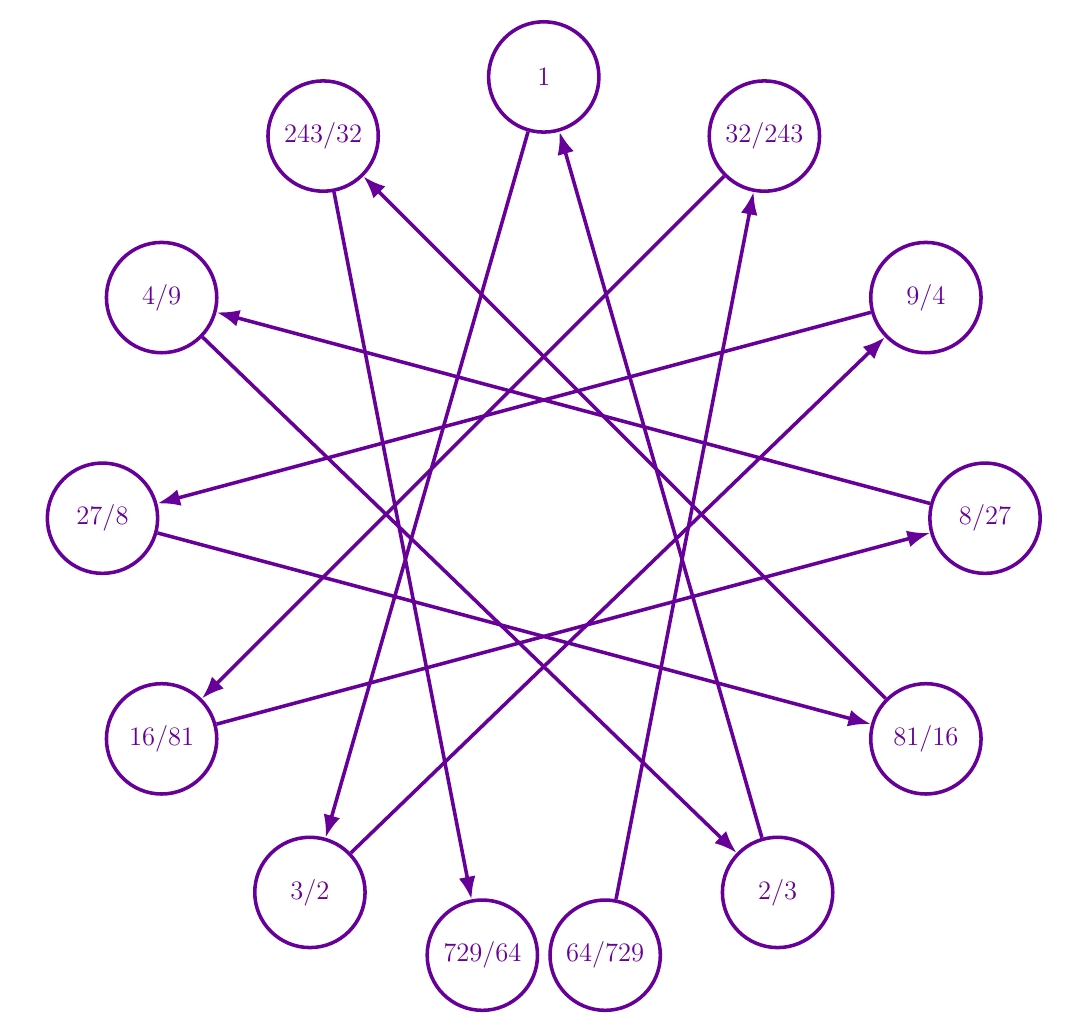
A point on this circle is a pitch class: two tones give the same pitch class if and only if their frequencies differ by a power of 2.
This circle shows that going up 6 fifths gets us to almost the same pitch class as going down 6 fifths. They're both very close to the tritone: the pitch class directly opposite our original frequency, 1. Taking advantage of these facts, we obtained the Pythagorean tuning system. For details, read my October 8th diary entry.
Let's try to mimic this procedure for 5-limit tuning! This gets a lot more interesting. Eventually it leads to a popular tuning system, or group of systems, called 'just intonation'.
Since multiplying the frequency by powers of 2 just changes the pitch by octaves, we can focus on powers of 3/2 and 5/4. As mentioned, the frequency ratio 3/2 is called a 'fifth', or more precisely a 'just perfect fifth'. Similarly, 5/4 is called a 'major third', or more precisely a 'just major third'. So, one way to think about 5-limit tuning is that it goes beyond 3-limit tuning by giving us access to the just major third.
It literally adds an extra dimension! Here we show a lattice with the number 1 at the center, where going one step east multiplies the number by 3/2 and going one step roughly northeast multiplies the number by 5/4:

In musical terms, going one step east takes us up a fifth, while going one step roughly northeast takes us up a third.
Why did I draw a triangular lattice instead of a rectangular one? For now you can think of it as a random artistic decision, but the resulting diagram is called a Tonnetz, which means 'tone network' in German, and later we'll see how useful it is.
Now let's repeat what we did for Pythagorean tuning: let's see how far we have to go before we reach almost the same pitch class in more than one way.
It turns out there are four ways to get very close to the tritone. These four ways are the corners of this parallelogram:
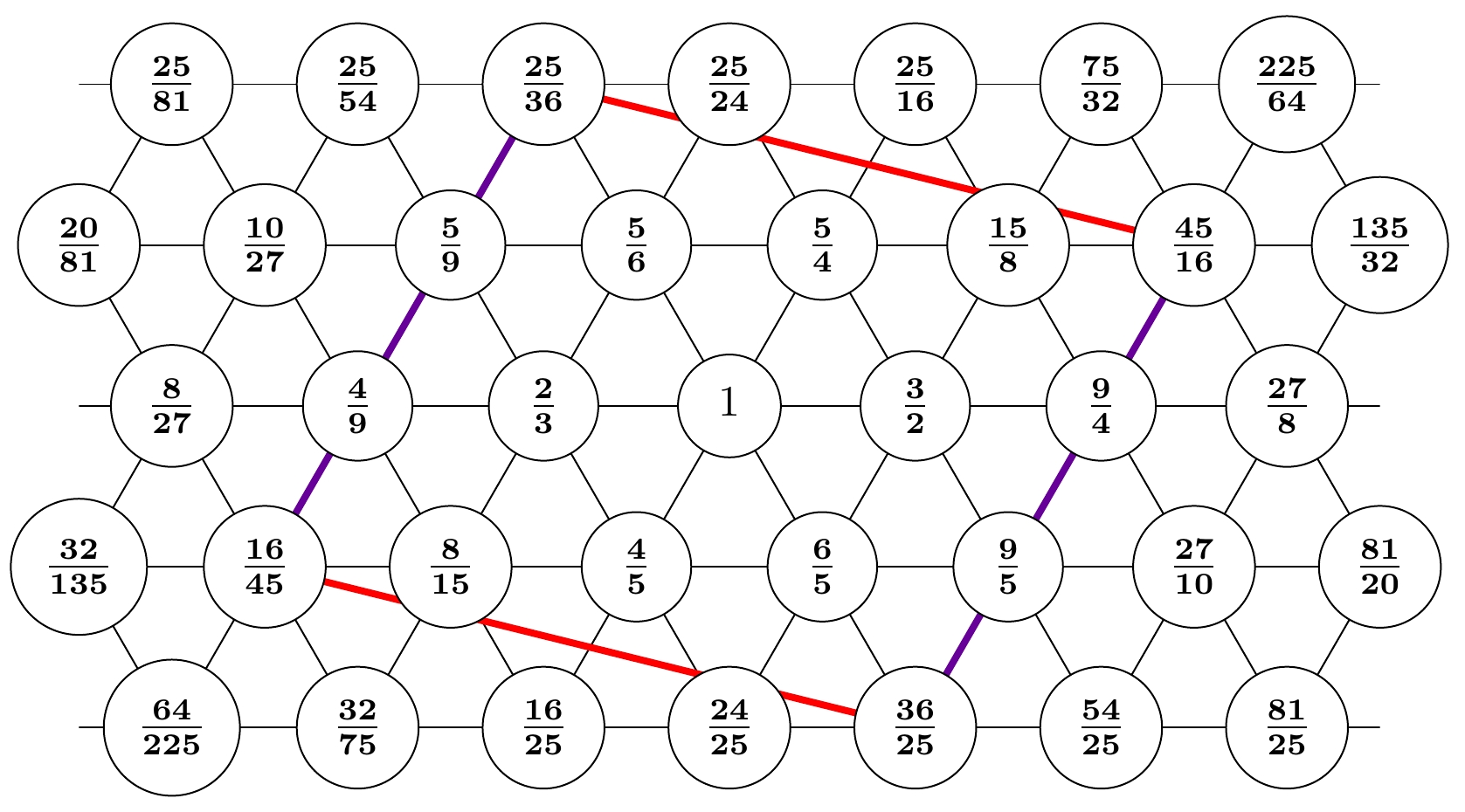
To clean up the picture, let's keep only the tones within this parallelogram (or on its boundary):

Now take these numbers and multiply them by suitable powers of 2 to keep them between 1 and 2. This gives tones lying between the tone at the center of the picture and the tone one octave above, as we'd want for a scale:
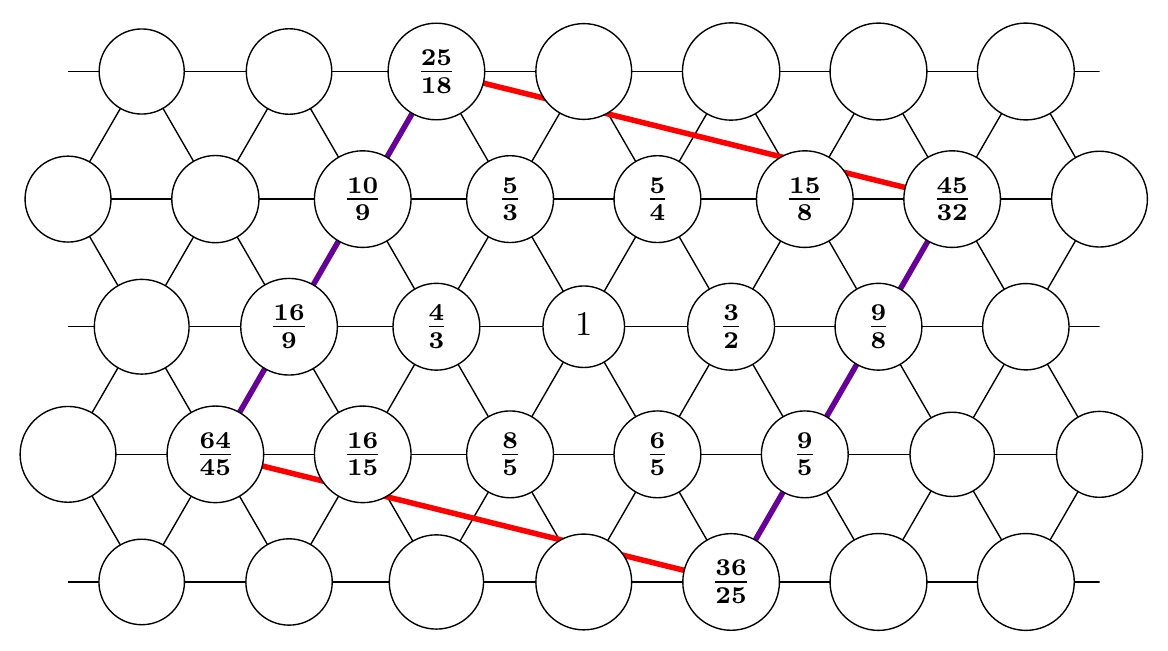
Now look at the numbers at the corners of this parallelogram! Let's check that they are close to a tritone, as I claimed. The tritone has frequency $$ \sqrt{2} \; \approx \; 1.414214 \dots $$ The corners are labeled by these numbers: $$ \begin{array}{ccl} \displaystyle{ \frac{25}{18} } &=& 1.38888\dots \\ \\ \displaystyle{ \frac{45}{32} } &=& 1.40625 \\ \\ \displaystyle{ \frac{64}{45} } &=& 1.42222 \dots \\ \\ \displaystyle{ \frac{36}{25} } &=& 1.44 \end{array} $$ So yes, they're pretty close!
Now for the cool part. Suppose we 'wrap around' this parallelogram to get a torus:

We identify the 4 tones on its left edge with the 4 tones on its right edge. Similarly, we identify the 2 tones on the top edge with the 2 tones on the bottom edge. And we're left with 12 tones — great for a 12-tone scale!
It's like magic, how the number 12 shows up yet again.
But there's a problem. The 4 tritones aren't equal, and the 4 numbers on the left edge don't equal the numbers on the right edge. They're close, but not quite equal! This is the same sort of problem that afflicted us in Pythagorean tuning, where we had two candidates for the tritone. But now we get 4 candidates for the tritone, 2 candidates for the major second, and 2 candidates for the minor seventh. So we get a scale with some choices: $$ \begin{array}{ll} \textrm{tonic} & \textrm{1} \\ \textrm{minor 2nd} & \textrm{16/15} \\ \textrm{major 2nd} & \textrm{10/9 or 9/8} \\ \textrm{minor 3rd} & \textrm{6/5} \\ \textrm{major 3rd} & \textrm{5/4} \\ \textrm{perfect 4th} & \textrm{4/3} \\ \textrm{tritone} & \textrm{25/18 or 45/32 or 65/45 or 36/25} \\ \textrm{perfect 5th} & \textrm{3/2} \\ \textrm{minor 6th} & \textrm{8/5} \\ \textrm{major 6th} & \textrm{5/3} \\ \textrm{minor 7th} & \textrm{16/9 or 9/5} \\ \textrm{major 7th} & \textrm{15/8} \\ \textrm{octave} & \textrm{2} \\ \end{array} $$ We need to make some decisions to get a specific scale.
But first, notice that the pattern would be clearer if we hadn't forced our frequencies to lie between 1 and 2 — that is, between the tonic and the octave. It's better if we force them to lie between \(1/\sqrt{2}\) and \(\sqrt{2}\) — that is, between the tritone below the tonic, and the tritone above. Then the Tonnetz has a beautiful symmetry:

For any number in the parallelogram, its reciprocal appears in the opposite position! If we use these numbers instead, we get this nicer table: $$ \begin{array}{ll} \textrm{tritone} & \textrm{25/36 or 32/45} \\ \textrm{perfect 5th} & \textrm{3/4} \\ \textrm{minor 6th} & \textrm{4/5} \\ \textrm{major 6th} & \textrm{5/6} \\ \textrm{minor 7th} & \textrm{8/9 or 9/10} \\ \textrm{major 7th} & \textrm{15/16} \\ \textrm{tonic} & \textrm{1} \\ \textrm{minor 2nd} & \textrm{16/15} \\ \textrm{major 2nd} & \textrm{10/9 or 9/8} \\ \textrm{minor 3rd} & \textrm{6/5} \\ \textrm{major 3rd} & \textrm{5/4} \\ \textrm{perfect 4th} & \textrm{4/3} \\ \textrm{tritone} & \textrm{45/32 or 36/25} \\ \end{array} $$ Now we can start at the tonic and either climb up to the tritone, or climb down to the tritone... using the reciprocals of the same numbers!
Okay, enough perfect mathematical beauty. We have some difficult decisions to make: we have to choose which frequencies we'll actually use for our scale.
Let's recall how it worked for Pythagorean tuning. There we had two choices of tritone. One approach would be to choose both, calling one the augmented 4th and one the diminished 5th. But this gives us a total of 13 tones in our scale! To get a 12-tone scale people typically keep one choice of tritone and discard the other. This causes various difficulties, which I explained on October 8th.
All these issues become even more complicated in 5-limit tuning, since now we have 4 choices of tritone, 2 choices of major second, and 2 choices of minor seventh. I'll talk about this later.
For now, I just want to point out this. If we only want a major scale, our decisions become much easier: we just need to choose which major 2nd we want! There are just two choices: 10/9 and 9/8. 10/9 is called the small just whole tone and it sounds like this, while 9/8 is called the large just whole tone and it sounds like this.
9/8 is arguably the simpler fraction, and it's the one we used in Pythagorean tuning. If we use 9/8 as our major second we get the following scale, which I'll compare with Pythagorean tuning: $$ \begin{array}{lccc} & \textbf{Pythagorean} && \textbf{just intonation} \\ \textbf{tonic} & 1 && 1 \\ \textbf{major 2nd} & 9/8 && 9/8 \\ \textbf{major 3rd} & 81/64 &>& 5/4 \\ \textbf{perfect 4th} & 4/3 && 4/3 \\ \textbf{perfect 5th} & 3/2 && 3/2 \\ \textbf{major 6th} & 27/16 &>& 5/3 \\ \textbf{major 7th} & 243/128 &>& 15/8 \\ \textbf{octave} & 2 && 2 \\ \end{array} $$ This scale was discussed by Claudius Ptolemy in his famous book Harmonikon roughly around 150 AD, and it's called Ptolemy's intense diatonic scale.
I don't know why it's called 'intense', but this form of just intonation is intensely beautiful. It was very popular from around 1300 (at least in England) to at least 1550 (by which time it had spread to all of Europe). In 1558, in his influential text Le istitutioni harmoniche, the music theorist Gioseffo Zarlino proclaimed that this scale was "the only one that can reasonably be sung" — even though he was busy introducing a more complex tuning system for keyboards, called meantone temperament.
The rise of just intonation from 1300 to 1550 went hand in hand with increased use of major triads, which later became the bread and butter of classical music. A major triad on a tone consists of:
The amazing thing about Ptolemy's intense diatonic scale is that all the notes lie in major triads on the three most important notes in the scale: the tonic, the perfect fourth and the perfect fifth. You can see it in this chart here:
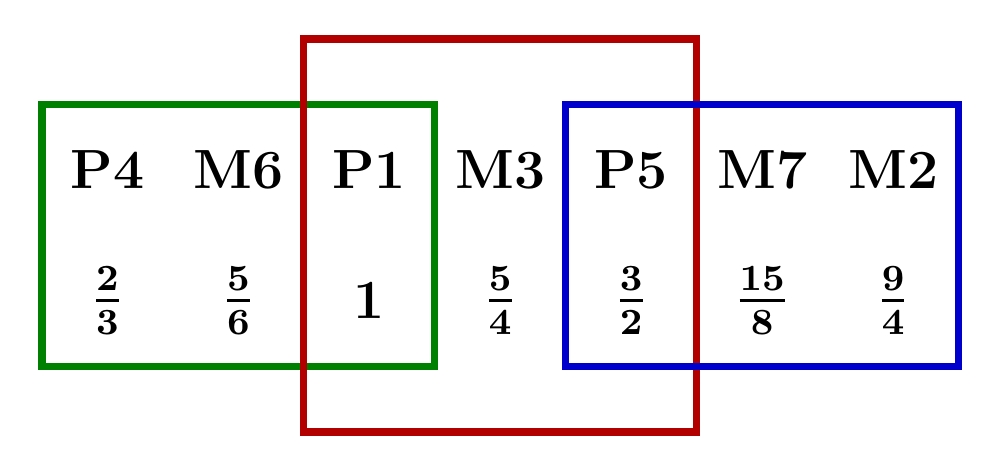
or if you prefer thinking in key of C major:
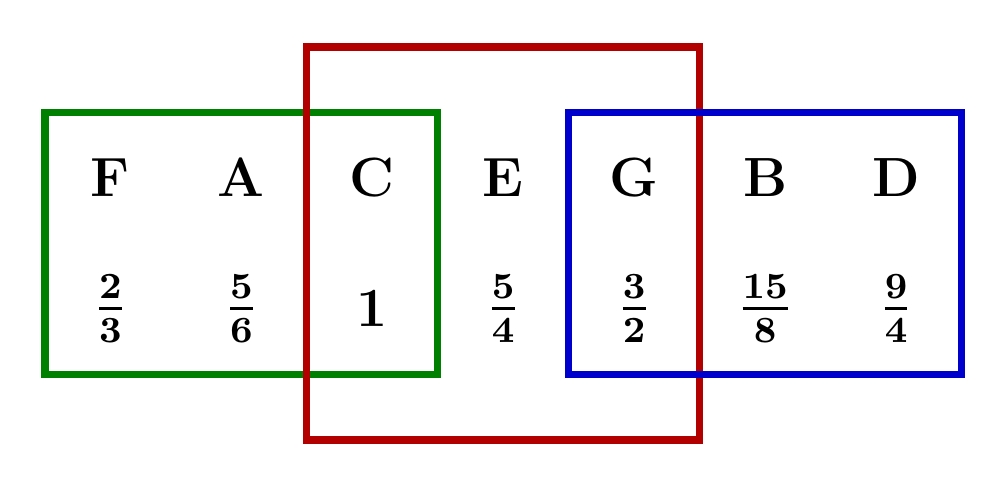
There are many more questions to answer when we go beyond Ptolemy's intense diatonic scale and construct a chromatic (i.e. 12-tone) scale based on 5-limit tuning. How do we choose between the 4 tritones? How do we choose between the two major 2nds — should we stick with the large just whole tone 9/8, or try the small just whole tone 10/9? How do we choose between the two minor 7ths? And what's the math underlying these choices?
I have a lot to say about this. There's also a lot more to say about
the Tonnetz. But all this will have to wait!
November 9, 2023
Last time I said a bit about 'just
intonation': that is, tuning where the most important notes have
frequency ratios that are simple fractions. I focused on the
historically important case of '5-limit tuning', where the frequency
ratios are products of powers of primes ≤ 5.
I went a long way toward getting some popular scales in 5-limit tuning. I started by drawing a chart called a 'Tonnetz' where going east multiplies the frequency by 3/2, and going roughly northeast multiplies the frequency by 5/4:
Then, I kept only the numbers in a parallelogram whose corners are numbers very close to a tritone, that is, \(\sqrt{2}\) or \(1/\sqrt{2}\):
Then I multiplied these numbers by appropriate powers of 2 to make them lie between 1 and 2:
If we curl this parallelogram up into a torus, this torus has exactly 12 notes on it! To curl it up, we need to glue each note on the parallelogram's left edge to its partner on the right edge:
We also need to glue each note on the parallelogram's top edge to its partner on the bottom:
The problem is that not all the notes we're gluing together have the same frequency! Luckily, they're close.
How close are these notes, exactly? That's what I want to analyze today. Believe it or not, music theorists have thought about this for thousands of years and made up special terms to describe the answers.
First let's compare the notes on the left edge of the parallelogram to their partners on the right edge:
If we work out their frequency ratios, we see the notes on the right are a bit higher than those on the left: \[ \begin{array}{ccl} \displaystyle{\frac{45/32}{25/18}} &=& \displaystyle{\frac{81}{80}} \\ \\ \displaystyle{\frac{9/8}{10/9}} &=& \displaystyle{\frac{81}{80}} \\ \\ \displaystyle{\frac{9/5}{16/9}} &=& \displaystyle{\frac{81}{80}} \\ \\ \displaystyle{\frac{36/25}{64/45}} &=& \displaystyle{\frac{81}{80}} \end{array} \] We always get the same ratio! And it's our friend the syntonic comma: \[ 81/80 = 1.0125 \] This is no accident, of course: it's built into the structure of the Tonnetz. In music terminology, when we go up 4 just perfect fifths and then go down a just major third and 2 octaves, the frequency gets multiplied by \[ 3/2 \times 3/2 \times 3/2 \times 3/2 \times 4/5 \times 1/2 \times 1/2 = 81/80 \] which is the syntonic comma.
So: curling up the parallelogram means deciding whether to use tones on the its left edge and tones on its right edge — which forces us into the jaws of the syntonic comma.
Next let's compare the notes on the top edge of the parallelogram to their partners on the bottom edge:
If we work out their frequency ratios, we see the notes on the bottom are a bit higher than their partners on the top: \[ \begin{array}{ccl} \displaystyle{\frac{64/45}{25/18}} &=& \displaystyle{\frac{128}{125}} \\ \displaystyle{\frac{36/25}{45/32}} &=& \displaystyle{\frac{128}{125}} \end{array} \] Yet another glitch! This number is called the lesser diesis: \[ 128/125 = 1.024 \] 'Diesis' is a Greek word meaning 'leak' or 'escape' — though 'glitch' might be a more idiomatic translation. In music terminology, if you go up an octave and then go down 3 just major thirds, the frequency gets multiplied by \[ 2 \times 4/5 \times 4/5 \times 4/5 = 128/125 \] which is the lesser diesis. You can see how this works by staring at the Tonnetz.
In short, when we curl up the parallelogram we have some choices to make concerning the major second, the tritone and the major seventh: \[ \begin{array}{ll} \textrm{tonic} & \textrm{1} \\ \textrm{minor 2nd} & \textrm{16/15} \\ \textrm{major 2nd} & \textrm{10/9 or 9/8} \\ \textrm{minor 3rd} & \textrm{6/5} \\ \textrm{major 3rd} & \textrm{5/4} \\ \textrm{perfect 4th} & \textrm{4/3} \\ \textrm{tritone} & \textrm{25/18 or 45/32 or 65/45 or 36/25} \\ \textrm{perfect 5th} & \textrm{3/2} \\ \textrm{minor 6th} & \textrm{8/5} \\ \textrm{major 6th} & \textrm{5/3} \\ \textrm{minor 7th} & \textrm{16/9 or 9/5} \\ \textrm{major 7th} & \textrm{15/8} \\ \textrm{octave} & \textrm{2} \\ \end{array} \] For the major second we have two choices whose ratio is the syntonic comma: 10/9 and 9/8. In a symmetrical way, for the minor seventh below the tonic we have two choices whose ratio is the syntonic comma: 8/9 and 9/10. But we multiply these choices by 2 to get choices for the minor seventh above the tonic: 16/9 and 9/5.
The biggest challenge involves the tritone, where we have four choices, coming from the corners of our parallelogram:
Here I've drawn arrows from lower tones to higher tones, and labeled each edge by the frequency ratio between the tones it connects.
The top and bottom edges have a frequency ratio of a syntonic comma, 81/80, while the left and right edges have a frequency ratio of a lesser diesis, 128/125. The diagonals also have standard names!
The diagonal from upper left to lower right gives a frequency ratio called the greater diesis: \[ \frac{36/25}{25/18} = \frac{648}{625} = 1.0368 \] In other words,
The diagonal from the upper right to the lower left gives a frequency ratio called the diaschisma: \[ \frac{64/45}{45/32} = \frac{2048}{2025} \approx 1.011358\dots \] In other words,
Apparently the diaschisma got its name from the physicist Helmholtz, but it was already studied by Boethius, who wrote a book called De musica in 510 AD. 'Schisma' means something like 'split', so I guess 'diaschisma' means 'the split between'.
Here you can see the syntonic comma, lesser and greater diesis, and diaschisma in decimals, to make it easier to compare how big they are:
Sometimes the tritone is called diabolus in musica — 'the devil in music'. The usual explanation is that this frequency ratio is so dissonant. But as we've seen, it's also devilishly difficult to deal with in just intonation! We have four choices. What should we do?
Stay tuned for more!
November 15, 2023
On November 6th we saw there are some
choices required when trying to pick a 12-note scale in just
intonation:
| tonic | 1 | |
| minor 2nd | 16/15 | |
| major 2nd | 10/9 or 9/8 | |
| minor 3rd | 6/5 | |
| major 3rd | 5/4 | |
| perfect 4th | 4/3 | |
| tritone | 25/18 or 45/32 or 64/45 or 36/25 | |
| perfect 5th | 3/2 | |
| minor 6th | 8/5 | |
| major 6th | 5/3 | |
| minor 7th | 16/9 or 9/5 | |
| major 7th | 15/8 | |
| octave | 2 |
Theoretically, there are
choices. But one is more popular than all the rest — at least in theory. Today I want to talk about that.
Beware: the heyday of just intonation was the Renaissance, but we have rather little information about the actual everyday practice of tuning back then. I wouldn't be surprised if many performers didn't give a fig about these numbers. What we mainly have is writings of theorists. They certainly knew their math. But I have not yet identified a passage in those old theoretical writings where someone commits to a specific 12-tone scale in just intonation. Quite possibly I haven't dug deep enough yet.
When I look around for such scales, modern authors tend to give this one:
| tonic | 1 | |
| minor 2nd | 16/15 | |
| major 2nd | 10/9 or 9/8 | |
| minor 3rd | 6/5 | |
| major 3rd | 5/4 | |
| perfect 4th | 4/3 | |
| tritone | 25/18 or 45/32 or 64/45 or 36/25 | |
| perfect 5th | 3/2 | |
| minor 6th | 8/5 | |
| major 6th | 5/3 | |
| minor 7th | 16/9 or 9/5 | |
| major 7th | 15/8 | |
| octave | 2 |
What's so good about this one?
First, 9/8 is a lot better than 10/9 for the major 2nd. I explained why already, at the end of my November 6th entry. Briefly, we need it so all the notes in the major scale lie in triads with frequency ratios 1 : 1.25 : 1.5. In C major these triads look like this:

Here the all-important 9/8 shows up as 9/4 since it's an octave up. And the chord in blue, containing the 9/4, has been incredibly important in western music ever since the Renaissance. You tend to play it right before the last chord in a piece of music! It's so bloody important that it has its own special name: the dominant chord.
Second, why should we pick 16/9 for the minor 7th instead of 9/5?
There could be valid musical reasons, but I don't know a compelling one, so I'll retreat to mathematics — a subject I actually know — and point out that this choice gives a scale that's symmetrical. That is, for each frequency in the scale, its reciprocal is also in the scale!
Now you may argue that this is baloney: the reciprocal of 16/9 is 9/16, and that's not on this list:
| tonic | 1 | |
| minor 2nd | 16/15 | |
| major 2nd | 9/8 | |
| minor 3rd | 6/5 | |
| major 3rd | 5/4 | |
| perfect 4th | 4/3 | |
| tritone | 45/32 | |
| perfect 5th | 3/2 | |
| minor 6th | 8/5 | |
| major 6th | 5/3 | |
| minor 7th | 16/9 | |
| major 7th | 15/8 | |
| octave | 2 |
True. You got me there! But 9/16 is just 9/8 divided by 2, which is on the list. Multiplying or dividing a frequency by a power of 2 gives another frequency in the same 'pitch class': they only differ by octaves. So musicians would say 9/16 really is in the scale, just an octave down.
In fact, the symmetry I'm talking about becomes a lot clearer if we list the tones in our scale going both up from the tonic and down from the tonic:
| perfect 5th | 3/4 | |
| minor 6th | 4/5 | |
| major 6th | 5/6 | |
| minor 7th | 8/9 | |
| major 7th | 15/16 | |
| tonic | 1 | |
| minor 2nd | 16/15 | |
| major 2nd | 9/8 | |
| minor 3rd | 6/5 | |
| major 3rd | 5/4 | |
| perfect 4th | 4/3 | |
Look: for each number on the list, its reciprocal on the list! Even better, the reciprocal of any 'major' tone is a 'minor' one, and vice versa. So flipping this scale upside down by taking reciprocals switches major and minor!
This is not a mere curiosity: it's a profound musical fact. Major is 'happy', minor is 'sad', and flipping one upside down gives the other... just like flipping a smile upside down gives a frown.
But you'll notice that to achieve this beautiful symmetry I left out the tritone. In fact, no single one of our original four choices of tritone:
gives a symmetrical scale. The reason is simple: none of these numbers is twice its reciprocal. To achieve that, we'd need to let the frequency of tritone be \(\sqrt{2}\). But that would be irrational.
So, people who want a symmetrical scale get it by choosing two tritones! They usually choose these two, which are reciprocals up to a factor of 2:
They call the smaller one the 'augmented 4th', and the larger one the 'diminished 5th'. Then we get a scale with this beautiful symmetry:
| diminished 5th | 32/45 | |
| perfect 5th | 3/4 | |
| minor 6th | 4/5 | |
| major 6th | 5/6 | |
| minor 7th | 8/9 | |
| major 7th | 15/16 | |
| tonic | 1 | |
| minor 2nd | 16/15 | |
| major 2nd | 9/8 | |
| minor 3rd | 6/5 | |
| major 3rd | 5/4 | |
| perfect 4th | 4/3 | |
| augmented 4th | 45/32 | |
Alas, we got this beautiful symmetry at the expense of having a 13-tone scale with two tones very close to each other. If we want 12 tones, we need to discard one. People usually discard the diminished 5th and keep the augmented 4th, namely 45/32.
Why? I'm not sure, but as a mathematician I'll note that the other choice gives a scale that's just an upside-down version of the scale people usually choose. So, I don't lose much by following the usual convention.
So there we are! We've made our choices as best we can. And since tuning theory is all about frustration, sticking to this approach gives us two choices, neither entirely pleasing:
and
Now let's examine each of these choices in more detail! I want to look at the spacings between the notes. Of course they are not equal: that only happens in equal temperament. But as you might expect, they have cool names. People have been studying this stuff for a long time.

Note that this scale has a beautiful up-down symmetry, as advertised!
There are four kinds of spacings between notes. Three are close to the usual spacing between notes on an equal-tempered piano. They're called half-tones, or semitones:
Our scale also has a tiny space between the augmented 4th and diminished 5th:
I discussed the diaschisma on November 9th, along with all the other tiny intervals between the four choices of tritone in just intonation:
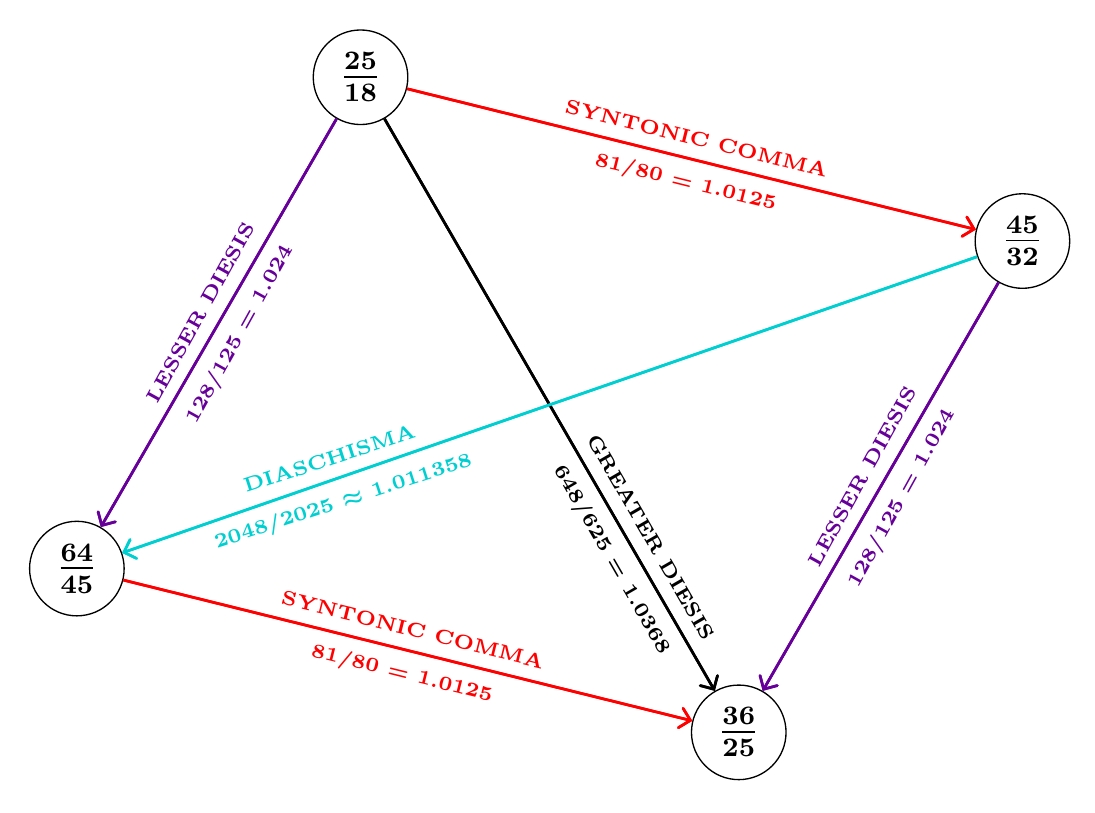
Now you can see why Boethius grappled with the diaschisma as early as 510 AD, though it was named much later by the great mathematician and physicist Helmholtz.
Here's another picture of our scale, which also shows the tones not chosen, in gray:
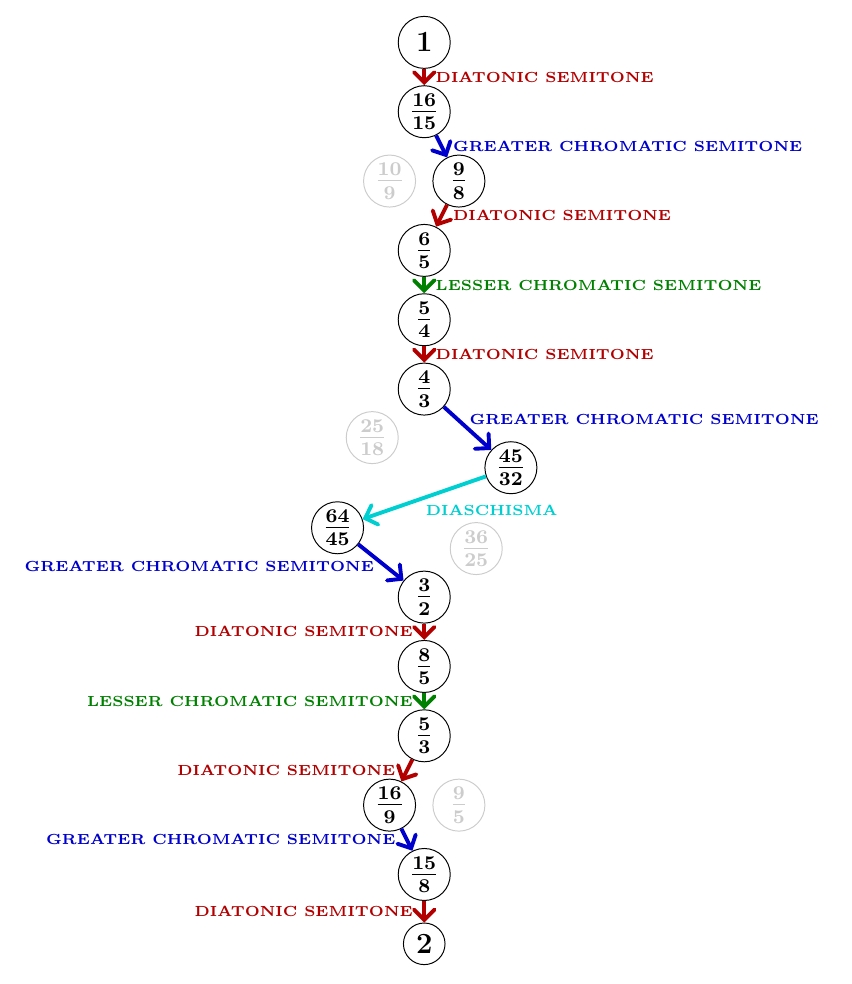
The up-down symmetry is very visible here.
But what if we create a 12-tone scale by removing the diminished 5th, as people seem to usually do? Then we break the up-down symmetry, and get this scale:
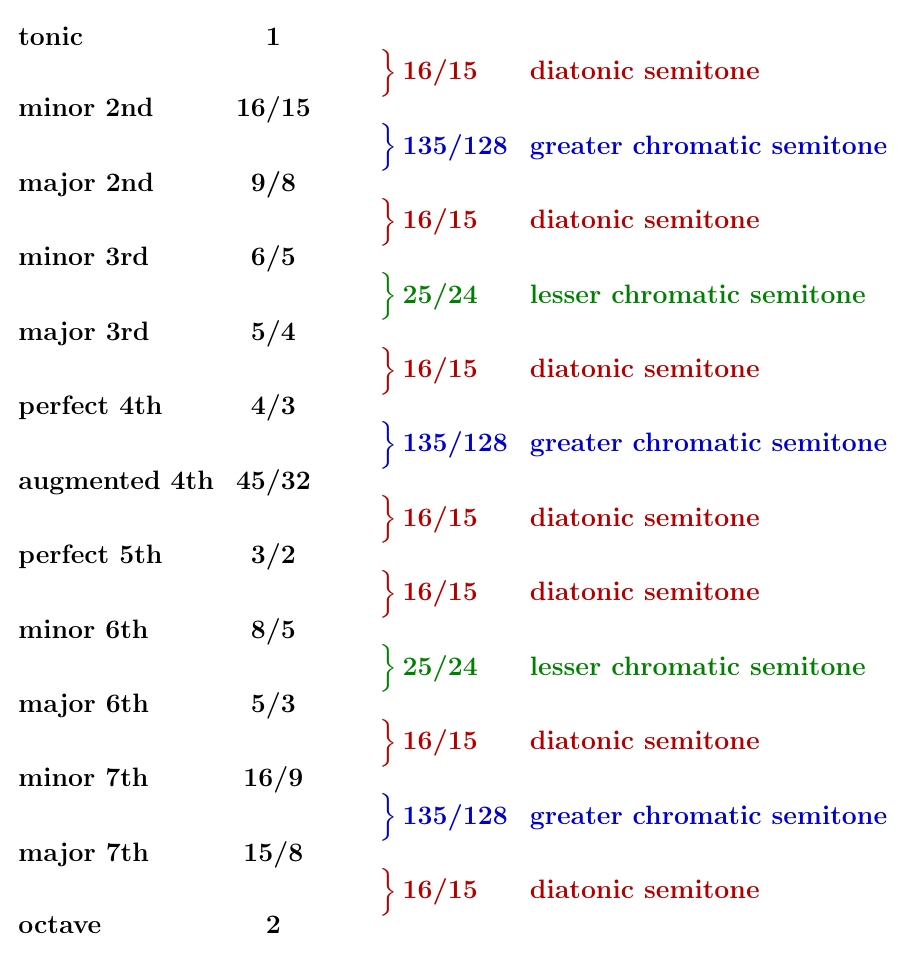
This seems to be the most popular 12-tone just intonation scale. For example, it was favored by Newton and Mersenne.
Compared to the symmetrical 13-tone scale it's based on, this scale has an extra diatonic semitone. There's a reason for that: when we discard the diminished 5th and jump all the way from the augmented 4th to the 5th, we stick the diaschisma onto one of the greater chromatic semitones we had. This gives a diatonic semitone, since
or in terms of numbers: $$ \displaystyle{ \frac{16}{15} = \frac{135}{128} \times \frac{2048}{2025} } $$
Okay, we have reached a natural stopping point for today. I have described the most popular 12-tone scale that uses just intonation! We have seen the frequencies of all its notes. We have also studied the spaces between its notes. What more could we want?
Well, remember that we chose two of the four possible tritones to be the augmented 4th and diminished 5th, namely these:
What if we chose the other two? We'd get another symmetrical 13-tone scale, and discarding its augmented 5th we'd get another 12-tone scale. What's wrong with that scale?
It actually is worse in some objective sense. But to see how, we need to look at it!
So, let's create a symmetrical 13-tone scale where we use the other two tritones as our augmented 4th and diminished 5th:
It looks like this:
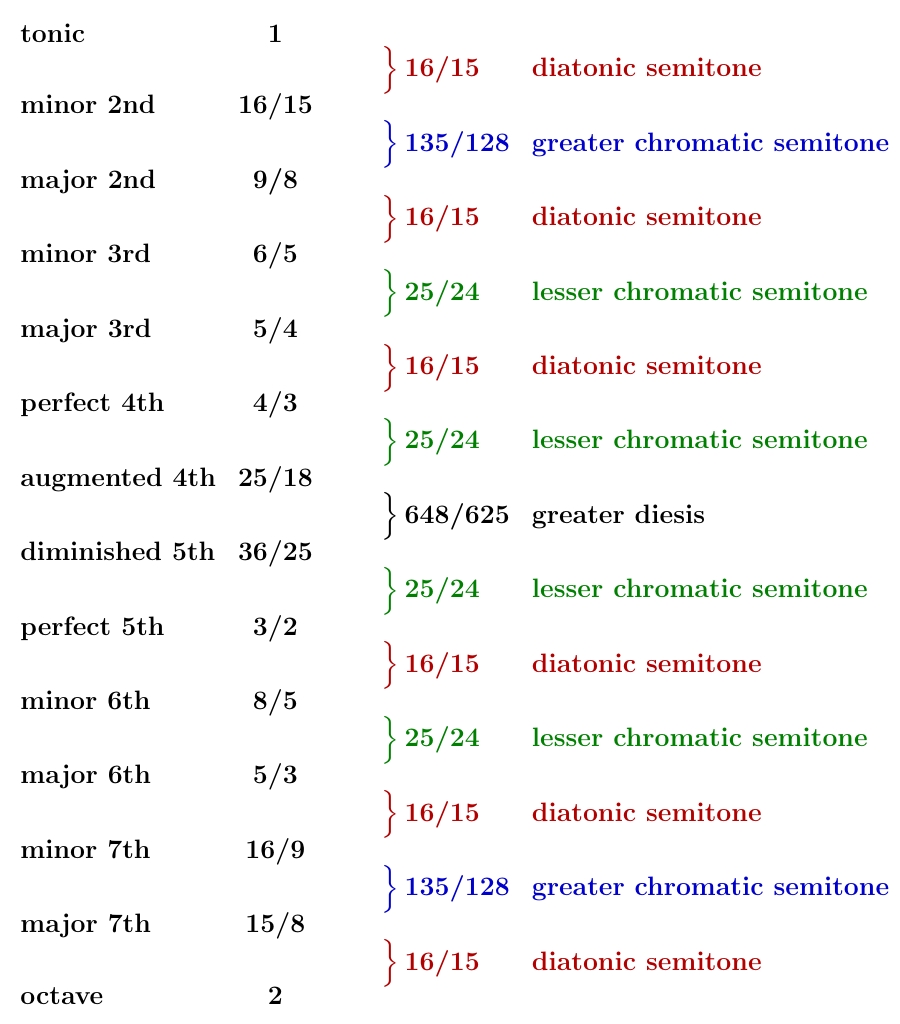
Now the space between the augmented 4th and diminished 5th is bit bigger! It's changed from the diaschisma to a larger interval:
The two neighboring spaces have therefore shrunk. In fact they've shrunk from greater chromatic semitones to lesser chromatic semitones, since
or in terms of numbers:
$$ \displaystyle{ \left(\frac{135/128}{25/24}\right)^2 = \frac{648/625}{2048/2025} } $$
Wild!
This scale doesn't look worse than our other symmetrical 13-tone scale: at least, not to me. It's when we create a 12-tone scale by discarding the diminished 5th that something funny happens.
Let's do it: let's throw out the diminished 5th! Then we get this scale:

Look! Not only does it lack up-down symmetry, as we expect — there's something else odd about it. It has four kinds of semitone! Yes: it has the three we've already seen, but also this:
This is significantly bigger than the other three semitones. And it's nasty to have to keep track of yet another kind of semitone. So, arguably, this scale is not as nice as the one people actually settled on. But the large diatonic semitone is still significant in music theory. Since we got it by sticking the greater diesis onto a lesser chromatic semitone, we get:
or in terms of numbers:
$$ \displaystyle{ \frac{27}{25} = \frac{25}{24} \times \frac{648}{625} } $$
By the way: if you find it impossible to remember these crazy numbers and the web of mathematical relations connecting them, don't feel bad. So do I! Next time I'll summarize all these mathematical relations using some pretty pictures.
Puzzle 1. As we've seen, the most popular 12-tone just intonation scale has 7 diatonic semitones, 3 greater chromatic semitones, and 2 lesser chromatic semitones:

By permuting these semitones we can get many other scales. How many different scales can we get this way?
Puzzle 2. Our second, less popular almost symmetrical 12-tone just intonation scale has 6 diatonic semitones, 2 greater chromatic semitones, 3 lesser chromatic semitones and 1 large diatonic semitone:

How many other scales can we get by permuting these semitones?
Of course these questions are warmups for a bigger question:
Puzzle 3. How many 12-tone scales are there where the spacing between each pair of successive notes is either a diatonic semitone, a greater chromatic semitone, a lesser chromatic semitone or a large diatonic semitone?
These alternative scales may seem pointless, but in fact some have been studied by famous music theorists or mathematicians. For example, in 1694 William Holder discussed a scale with 5 lesser chromatic semitones, no greater chromatic semitones, 4 diatonic semitones and 3 large diatonic semitones!
(For answers to these puzzles see my December 29, 2025 diary entry.)
November 17, 2023
On November 9th we saw that in just
intonation there are four candidates for
the tritone. They
are simple fractions close to the square root of 2. We saw that they
lie at the corners of a parallelogram in a diagram called the tone
network, or Tonnetz:

To get a 12-tone scale from this parallelogram, we need to think about the tiny differences between these 4 numbers. More precisely, since our ear hears frequency ratios, we need to think about the ratios of these 4 numbers, which are close to 1. Because people have been thinking about them for centuries, they all have cool names:

Here I've drawn arrows from tones of lower frequency to tones of higher frequency, and labeled these arrows by the frequency ratios.
In Part 4 we studied how to get a 12-tone scale in just intonation. I described two ways. In the most popular way, the spaces between tones come in 3 different sizes. But I also described another way, which is a bit less nice because the spaces between notes come in 4 different sizes. These 4 sizes are called semitones, but each has it own individual name.
Now for something cool. Let's draw a parallelogram with these 4 semitones as corners. Let's draw arrows from those of lower frequency to those of higher frequency, and label these arrows by the frequency ratios:
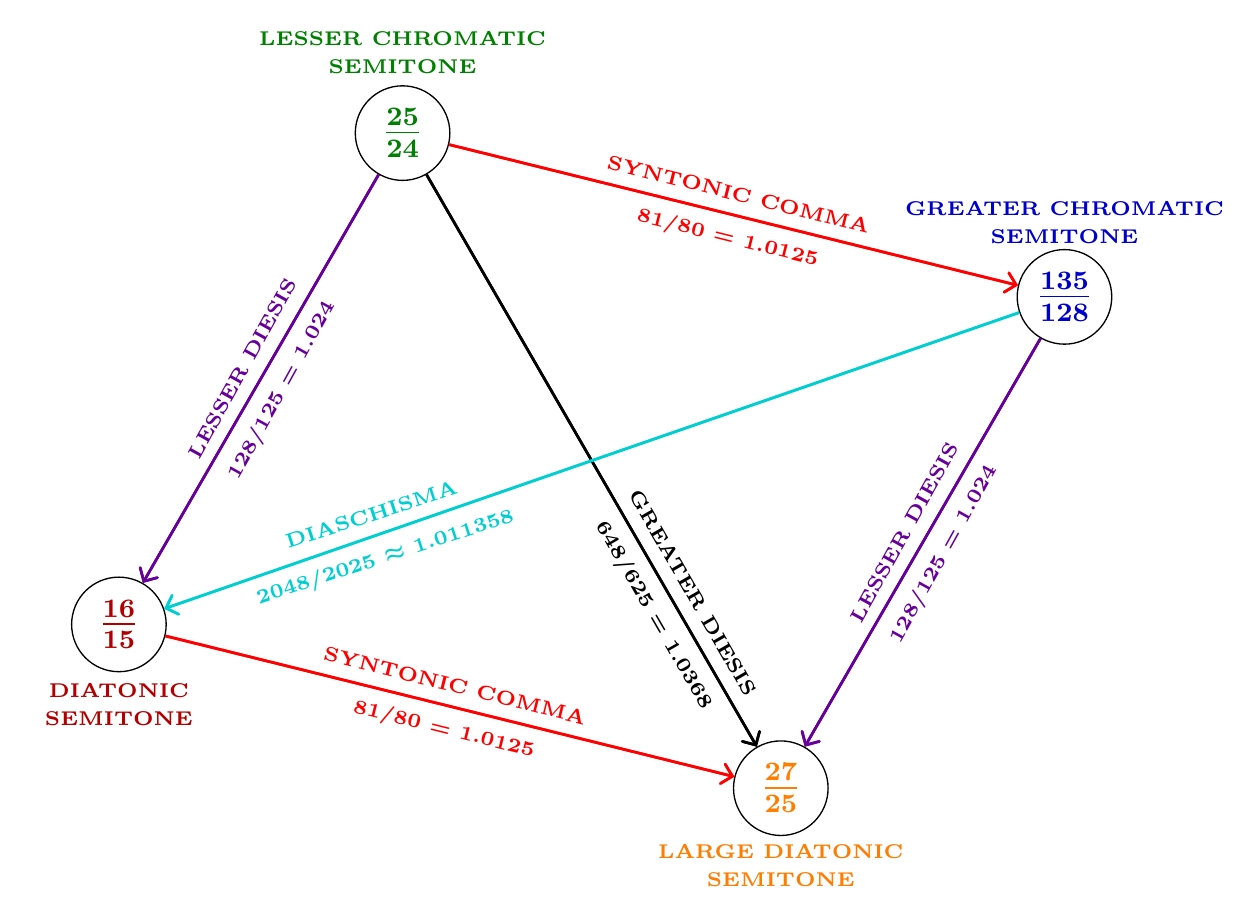
Hey! The frequency ratios are just the same as in our other parallelogram!
What's going on?
Here's what: when we take the parallelogram of semitones and shift it up a perfect fourth, we get the parallelogram of tritones!
Let me spell that out more carefully. It turns out that each tritone in our first parallelogram is a semitone higher than the perfect fourth, 4/3. But there are 4 kinds of semitone, so we get 4 kinds of tritone: $$ \begin{array}{ccl} \displaystyle{ \frac{25}{24} \times \frac{4}{3}} &=& \displaystyle{\frac{25}{18}} \\ \\ \displaystyle{ \frac{135}{128} \times \frac{4}{3}} &=& \displaystyle{\frac{45}{32}} \\ \\ \displaystyle{ \frac{16}{15} \times \frac{4}{3}} &=& \displaystyle{\frac{64}{45}} \\ \\ \displaystyle{ \frac{27}{25} \times \frac{4}{3}} &=& \displaystyle{\frac{36}{25}} \end{array} $$ So there's less going on than meets the eye: everything fits together.
We can also draw our parallelogram of semitones with the tonic, that is the frequency 1, in the middle:
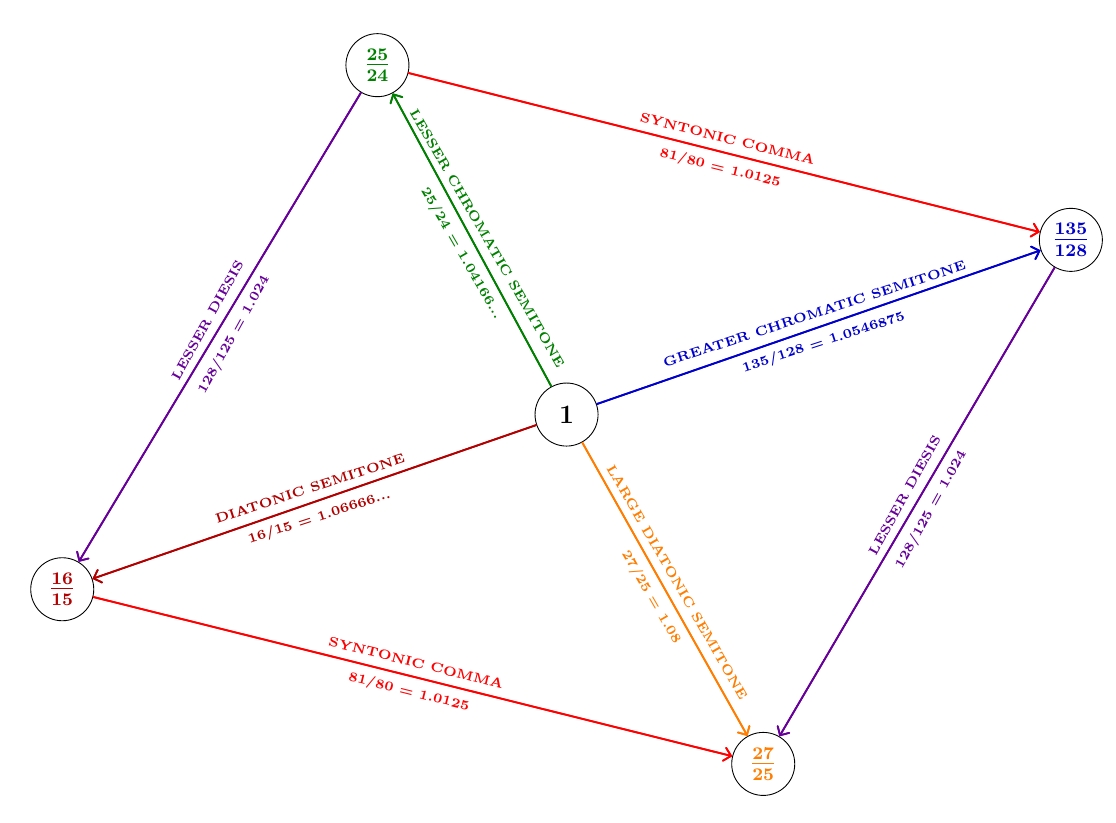
The arrows here should make you think of vector addition, where adding two sides of a triangle can give you the third if the arrows are pointing the right way. But here the edges are just numbers, and we combine them by multiplying them. So each triangle in this picture gives an identity:
So you don't need to remember all these identities: they're all in the picture!
Our earlier picture describes the frequency ratios of the semitones at the opposite corners of this parallelogram:

So it gives two more identities:
But again, the picture relieves you of the need to remember the identities. And you don't need to learn all the fancy names for things if you don't want to!
It's a bit like trigonometry. You can learn the names of lots of trig functions and identities relating them. Or you can just learn to understand the sine and cosine and the identities relating those. Or you can just learn to understand the function \(\exp(ix)\) and a couple of identities it obeys. The more you use trigonometry, or the more you enjoy it, the more it pays to remember. If you really love trigonometry and its history, learn about the versine:

Or go hog wild: learn about the haversine, the coversine, the vercosine, the covercosine, and more!
But if you don't want to learn this stuff, it's fine to take a more economical approach.
Puzzle 1. I drew the number 1 at the center of this parallelogram of semitones:

But what should really be at the center?
Puzzle 2. If we use the same logic, what should be at the center of this parallelogram of tritones?
